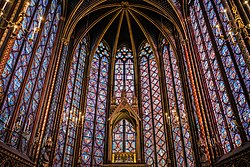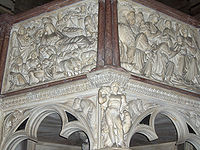Gothic art 哥特式艺术
Top: The Western (Royal) Portal of the Chartres Cathedral (circa 1145), these architectural statues being the earliest Gothic sculptures and a revolution in style and the model for a generation of sculptors; Centre: The Sainte-Chapelle from Paris (1194-1248); Bottom: The Wilton Diptych (1395–1459) 上图:沙特尔大教堂的西门(皇家)(约 1145 年),这些建筑雕像是最早的哥特式雕塑,也是风格的革命和一代雕塑家的典范;中图:巴黎的圣礼拜堂(1194-1248 年);下图:沙特尔大教堂的西门(皇家)(约 1145 年),这些建筑雕像是最早的哥特式雕塑,也是风格的革命和一代雕塑家的典范:中:巴黎的圣礼拜堂(1194-1248 年);下:威尔顿双联雕像(1313-1314 年):威尔顿双联画(1395-1459 年) | |
| Years active 活跃年代 | Late 12th century-16th century 12 世纪晚期至 16 世纪 |
|---|---|
Gothic art was a style of medieval art that developed in Northern France out of Romanesque art in the 12th century AD, led by the concurrent development of Gothic architecture. It spread to all of Western Europe, and much of Northern, Southern and Central Europe, never quite effacing more classical styles in Italy. In the late 14th century, the sophisticated court style of International Gothic developed, which continued to evolve until the late 15th century. In many areas, especially Germany, Late Gothic art continued well into the 16th century, before being subsumed into Renaissance art. Primary media in the Gothic period included sculpture, panel painting, stained glass, fresco and illuminated manuscripts. The easily recognizable shifts in architecture from Romanesque to Gothic, and Gothic to Renaissance styles, are typically used to define the periods in art in all media, although in many ways figurative art developed at a different pace.
哥特式艺术是一种中世纪艺术风格,于公元 12 世纪在法国北部由罗马式艺术发展而来,与此同时,哥特式建筑也得到了发展。它传播到整个西欧,以及北欧、南欧和中欧的大部分地区,但从未完全取代意大利的古典风格。14 世纪晚期,国际哥特式的精致宫廷风格发展起来,这种风格一直延续到 15 世纪晚期。在许多地区,尤其是德国,晚期哥特式艺术一直延续到 16 世纪,之后被并入文艺复兴艺术。哥特时期的主要艺术形式包括雕塑、板画、彩色玻璃、壁画和手抄本。从罗马式风格到哥特式风格,从哥特式风格到文艺复兴风格,这些易于辨认的建筑风格转变通常被用来定义所有媒介艺术的各个时期,尽管在许多方面,具象艺术的发展速度有所不同。
The earliest Gothic art was monumental sculpture, on the walls of Cathedrals and abbeys. Christian art was often typological in nature (see Medieval allegory), showing the stories of the New Testament and the Old Testament side by side. Saints' lives were often depicted. Images of the Virgin Mary changed from the Byzantine iconic form to a more human and affectionate mother, cuddling her infant, swaying from her hip, and showing the refined manners of a well-born aristocratic courtly lady.
最早的哥特式艺术是大教堂和修道院墙壁上的纪念碑雕塑。基督教艺术通常具有典型性(见中世纪寓言),将《新约全书》和《旧约全书》的故事并排展示。圣人的生活也经常被描绘出来。圣母玛利亚的形象从拜占庭时期的偶像形象转变为更人性化、更亲切的母亲形象,她搂着婴儿,摇摆着臀部,展现出出身良好的贵族宫廷淑女的优雅举止。
Secular art came into its own during this period with the rise of cities, foundation of universities, increase in trade, the establishment of a money-based economy and the creation of a bourgeois class who could afford to patronize the arts and commission works, resulting in a proliferation of paintings and illuminated manuscripts. Increased literacy and a growing body of secular vernacular literature encouraged the representation of secular themes in art. With the growth of cities, trade guilds were formed and artists were often required to be members of a painters' guild. As a result, because of better record keeping, more artists are known to us by name in this period than any previous; some artists were even so bold as to sign their names.
这一时期,随着城市的崛起、大学的建立、贸易的增长、货币经济的建立以及有能力赞助艺术和委托创作的资产阶级的出现,世俗艺术开始崭露头角,从而导致绘画和手稿彩饰的大量涌现。识字率的提高和越来越多的世俗白话文学鼓励在艺术中表现世俗主题。随着城市的发展,行会应运而生,艺术家通常也需要加入画家行会。因此,由于更好地保存了记录,这一时期比以往任何时期都有更多艺术家的名字为我们所知;有些艺术家甚至大胆地在自己的名字上签名。
Origins 起源[edit]
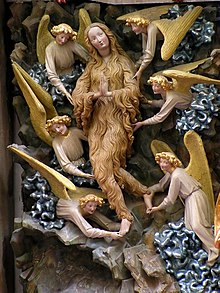
14 世纪托伦圣约翰大教堂的国际哥特式抹大拉的玛丽亚。
Gothic art emerged in Île-de-France, France, in the early 12th century, at the Abbey Church of St Denis built by Abbot Suger.[1] The style rapidly spread beyond its origins in architecture to sculpture, both monumental and personal in size, textile art, and painting, which took a variety of forms, including fresco, stained glass, the illuminated manuscript, and panel painting.[2] Monastic orders, especially the Cistercians and the Carthusians, were important builders who disseminated the style and developed distinctive variants of it across Europe. Regional variations of architecture remained important, even when, by the late 14th century, a coherent universal style known as International Gothic had evolved, which continued until the late 15th century, and beyond in many areas.
哥特式艺术兴起于 12 世纪初法国法兰西岛,由修道院院长苏格建造的圣德尼修道院教堂。0# 这一风格迅速蔓延,从最初的建筑风格发展到雕塑(包括纪念性雕塑和个人雕塑)、纺织品艺术和绘画(形式多样,包括壁画、彩色玻璃、照明手稿和镶板绘画)。1# 修道院,尤其是西斯特尔会和卡尔惕斯会,是重要的建筑师,他们在欧洲各地传播了这种风格,并发展出独特的变体。即使到了 14 世纪晚期,一种被称为国际哥特式的统一的普遍风格已经形成,这种风格一直延续到 15 世纪晚期,在许多地区甚至超过了 15 世纪晚期,但地区性的建筑变体仍然非常重要。
Although there was far more secular Gothic art than is often thought today, as generally the survival rate of religious art has been better than for secular equivalents, a large proportion of the art produced in the period was religious, whether commissioned by the church or by the laity.
Gothic art was often typological in nature, reflecting a belief that the events of the Old Testament pre-figured those of the New, and that this was indeed their main significance. Old and New Testament scenes were shown side by side in works like the Speculum Humanae Salvationis, and the decoration of churches. The Gothic period coincided with a great resurgence in Marian devotion, in which the visual arts played a major part. Images of the Virgin Mary developed from the Byzantine hieratic types, through the Coronation of the Virgin, to more human and intimate types, and cycles of the Life of the Virgin were very popular. Artists like Giotto, Fra Angelico and Pietro Lorenzetti in Italy, and Early Netherlandish painting, brought realism and more natural humanity to art. Western artists, and their patrons, became much more confident in innovative iconography, and much more originality is seen, although copied formulae were still used by most artists.
虽然世俗的哥特式艺术远比今天人们通常认为的要多,因为宗教艺术的存世率一般要比世俗艺术的存世率高,但这一时期的大部分艺术作品都是宗教艺术,无论是受教会委托还是由俗人创作。哥特式艺术通常具有类型学的性质,反映了一种信念,即《旧约》中的事件预示着《新约》中的事件,这确实是它们的主要意义所在。旧约》和《新约》的场景并列出现在《人类救赎书》(Speculum Humanae Salvationis)等作品和教堂装饰中。哥特式时期恰逢玛利亚奉献精神的大复兴,视觉艺术在其中发挥了重要作用。圣母玛利亚的形象从拜占庭时期的等级式发展到圣母加冕式,再发展到更人性化、更亲切的类型,而圣母生平的循环也非常流行。意大利的乔托、弗拉-安杰利科和皮耶罗-洛伦泽蒂等艺术家以及早期尼德兰绘画为艺术带来了现实主义和更自然的人性。西方艺术家和他们的赞助人在创新圣像艺术方面变得更加自信,尽管大多数艺术家仍在使用复制的公式,但原创性却大大增加。
Iconography was affected by changes in theology, with depictions of the Assumption of Mary gaining ground on the older Death of the Virgin, and in devotional practices such as the Devotio Moderna, which produced new treatments of Christ in subjects such as the Man of Sorrows, Pensive Christ and Pietà, which emphasized his human suffering and vulnerability, in a parallel movement to that in depictions of the Virgin. Even in Last Judgements Christ was now usually shown exposing his chest to show the wounds of his Passion. Saints were shown more frequently and altarpieces showed saints relevant to the particular church or donor in attendance on a Crucifixion or enthroned Virgin and Child, or occupying the central space themselves (this usually for works designed for side-chapels). Over the period many ancient iconographical features that originated in New Testament apocrypha were gradually eliminated under clerical pressure, like the midwives at the Nativity, though others were too well-established, and considered harmless.[3]
圣母升天 "的描绘取代了旧式的 "圣母之死",而 "现代奉献"(Devotio Moderna)等虔诚仪式也对圣像画产生了影响,在 "悲哀之人"、"沉思的基督 "和 "圣母像 "等主题中对基督进行了新的处理,强调了他的苦难和脆弱,这与圣母描绘的运动是并行不悖的。即使在《最后的审判》中,基督也通常袒露胸膛,以显示他受难时的伤口。圣人的形象被更多地表现出来,祭坛画中的圣人与特定教堂或捐赠者有关,他们在耶稣受难或圣母和圣婴就座时出现,或占据中心位置(这通常是为侧壁设计的作品)。在这一时期,许多源于《新约圣经》启示录的古代圣像特征在教士的压力下逐渐被取消,如耶稣降生时的接生婆,但也有一些圣像特征因过于成熟而被认为是无害的。 [3]
Etymology 词源[edit]
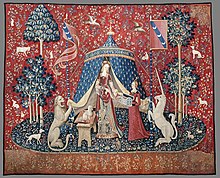
夫人与独角兽》是在佛兰德斯编织的六幅挂毯系列的标题,这幅名为《我的唯一梦想》;15 世纪晚期;羊毛和丝绸;377 x 473 厘米;克吕尼博物馆(巴黎)。
The word "Gothic" for art was initially used as a synonym for "Barbaric", and was therefore used pejoratively.[4] Its critics saw this type of Medieval art as unrefined and too remote from the aesthetic proportions and shapes of Classical art.[5] Renaissance authors believed that the Sack of Rome by the Gothic tribes in 410 had triggered the demise of the Classical world and all the values they held dear. In the 15th century, various Italian architects and writers complained that the new "barbarian" styles filtering down from north of the Alps posed a similar threat to the classical revival promoted by the early Renaissance.[6] The "Gothic" qualifier for this art was first used in Raphael's letter to Pope Leo X c. 1518 and was subsequently popularised by the Italian artist and writer Giorgio Vasari,[7] who used it as early as 1530, calling Gothic art a "monstrous and barbarous" "disorder".[8] Raphael claimed that the pointed arches of northern architecture were an echo of the primitive huts the Germanic forest dwellers formed by bending trees together – a myth which would resurface much later in a more positive sense in the writings of the German Romantic movement. "Gothic art" was strongly criticized by French authors such as Boileau, La Bruyère, Rousseau, before becoming a recognized form of art, and the wording becoming fixed.[5] Molière would famously comment on Gothic:
艺术中的 "哥特式 "一词最初是 "野蛮 "的同义词,因此带有贬义。 [4] 其批评者认为这种中世纪艺术不精致,与古典艺术的审美比例和造型相去甚远。 [5] 文艺复兴时期的作家们认为,410 年哥特部落攻陷罗马引发了古典世界和他们所珍视的所有价值观的消亡。15 世纪,许多意大利建筑师和作家抱怨说,从阿尔卑斯山以北流传下来的新的 "野蛮人 "风格对文艺复兴早期提倡的古典复兴构成了类似的威胁。 [6] 对这种艺术的 "哥特式 "修饰语最早出现在拉斐尔约 1518 年写给教皇利奥十世的信中,后来被意大利艺术家和作家乔治-瓦萨里(Giorgio Vasari)推广, [7] 他早在 1530 年就使用了这一修饰语,称哥特式艺术是一种 "畸形和野蛮 "的 "混乱"。 [8] 拉斐尔声称,北方建筑的尖拱是日耳曼森林居民通过将树木弯曲在一起而形成的原始小屋的回声--这个神话后来在德国浪漫主义运动的著作中以更积极的意义再次出现。"哥特式艺术 "在成为一种公认的艺术形式之前,曾受到法国作家布瓦洛(Boileau)、拉布吕耶尔(La Bruyère)和卢梭(Rousseau)等人的强烈批评,其措辞也被固定下来。 [5] 莫里哀曾对哥特式进行过著名的评论:
In its beginning, Gothic art was initially called "French work" (Opus Francigenum), thus attesting the priority of France in the creation of this style.[5]
哥特式艺术在诞生之初被称为 "法国作品"(Opus Francigenum),从而证明了法国在这一风格的创造中的优先地位。 [5]
Painting 绘画[edit]
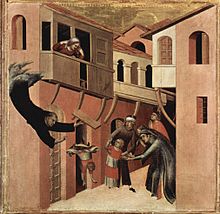
西蒙-马蒂尼(1285-1344 年)。
Painting in the Gothic style did not exist until around 1200, over 50 years after the beginnings of Gothic architecture and sculpture. The transition from Romanesque to Gothic is very imprecise and not at all a clear break, and Gothic ornamental detailing is often introduced before much change is seen in the style of figures or compositions themselves. Then figures become more animated in pose and facial expression, tend to be smaller in relation to the background of scenes, and are arranged more freely in the pictorial space, where there is room. This transition occurs first in England and France around 1200, in Germany around 1220 and Italy around 1300. Painting during the Gothic period was practiced in four primary media: frescos, panel paintings, manuscript illumination and stained glass.
哥特式风格的绘画直到 1200 年左右才出现,比哥特式建筑和雕塑的开端晚了 50 多年。从罗马式到哥特式的过渡并不精确,也没有明显的断裂,通常是在人物或构图风格发生很大变化之前就引入了哥特式装饰细节。随后,人物的姿势和面部表情变得更加生动,相对于场景背景的比例趋于缩小,在有空间的情况下,人物在画面空间中的排列也更加自由。这种转变首先出现在 1200 年左右的英国和法国,1220 年左右出现在德国,1300 年左右出现在意大利。哥特时期的绘画有四种主要媒介:壁画、镶板画、手稿照明和彩色玻璃。
Frescos 壁画[edit]
Frescos continued to be used as the main pictorial narrative craft on church walls in southern Europe as a continuation of early Christian and Romanesque traditions. An accident of survival has given Denmark and Sweden the largest groups of surviving church wall paintings in the Biblia pauperum style, usually extending up to recently constructed cross vaults. In both Denmark and Sweden, they were almost all covered with limewash after the Reformation which has preserved them, but some have also remained untouched since their creation. Among the finest examples from Denmark are those of the Elmelunde Master from the Danish island of Møn who decorated the churches of Fanefjord, Keldby and Elmelunde.[9] Albertus Pictor is arguably the most well-known fresco artist from the period working in Sweden. Examples of Swedish churches with well-preserved frescos include Tensta, Gökhem and Anga churches.
壁画作为早期基督教和罗马式传统的延续,继续被用作南欧教堂墙壁上的主要绘画叙事工艺。丹麦和瑞典是现存《圣经》贫民窟风格教堂壁画最多的国家,这些壁画通常一直延伸到最近建造的十字拱顶。在丹麦和瑞典,这些壁画在宗教改革后几乎都被石灰水覆盖,因此得以保存下来,但也有一些壁画自创作以来从未被人碰过。丹麦最精美的作品包括来自丹麦芒恩岛的埃尔梅隆德大师的作品,他装饰了法内菲尤德、凯尔比和埃尔梅隆德的教堂。阿尔贝特斯-皮克托(Albertus Pictor)可以说是这一时期瑞典最著名的壁画艺术家。瑞典壁画保存完好的教堂包括滕斯塔教堂、戈克姆教堂和安加教堂。
Stained glass 彩绘玻璃[edit]

1444 年德国彩色玻璃板的一部分,上面有瞻礼图;各种颜色的盆状金属,包括白色玻璃、黑色玻璃涂料、黄色银染色剂,"橄榄绿 "部分是珐琅。红色天空中的植物图案是在烧制前刮去红色玻璃上的黑色颜料形成的。修复后的面板,配有新的铅制底座。
In northern Europe, stained glass was an important and prestigious form of painting until the 15th century, when it became supplanted by panel painting. Gothic architecture greatly increased the amount of glass in large buildings, partly to allow for wide expanses of glass, as in rose windows. In the early part of the period mainly black paint and clear or brightly coloured glass was used, but in the early 14th century the use of compounds of silver, painted on glass which was then fired, allowed a number of variations of colour, centred on yellows, to be used with clear glass in a single piece. By the end of the period designs increasingly used large pieces of glass which were painted, with yellows as the dominant colours, and relatively few smaller pieces of glass in other colours.[10]
在北欧,彩色玻璃一直是一种重要而有声望的绘画形式,直到 15 世纪才被镶板绘画所取代。哥特式建筑大大增加了大型建筑中的玻璃数量,部分原因是可以使用宽大的玻璃,如玫瑰窗。早期主要使用黑色颜料和透明或色彩鲜艳的玻璃,但到了 14 世纪早期,使用银化合物在玻璃上绘画,然后烧制,这样就可以在一块透明玻璃上使用以黄色为中心的多种色彩变化。到这一时期末期,设计中越来越多地使用大块涂漆玻璃,以黄色为主色调,而使用其他颜色的小块玻璃则相对较少。 [10]
Manuscripts and printmaking
手稿和版画[edit]

让-普凯尔创作的《让娜-德-埃夫勒的小时》,巴黎,13 世纪 20 年代。
Illuminated manuscripts represent the most complete record of Gothic painting, providing a record of styles in places where no monumental works have otherwise survived. The earliest full manuscripts with French Gothic illustrations date to the middle of the 13th century.[11] Many such illuminated manuscripts were royal bibles, although psalters also included illustrations; the Parisian Psalter of Saint Louis, dating from 1253 to 1270, features 78 full-page illuminations in tempera paint and gold leaf.[12]
插图手稿是哥特式绘画最完整的记录,在没有其他纪念性作品存世的地方提供了风格记录。最早带有法国哥特式插图的完整手稿可追溯到 13 世纪中叶。许多此类插图手稿都是皇家圣经,尽管诗篇也包括插图;1253-1270 年的巴黎圣路易诗篇有 78 幅用蛋彩颜料和金箔绘制的整页插图。 [12]
During the late 13th century, scribes began to create prayer books for the laity, often known as books of hours due to their use at prescribed times of the day.[12] Among the earliest is an example by William de Brailes that seems to have been written for an unknown laywoman living in a small village near Oxford in about 1240. Nobility frequently purchased such texts, paying handsomely for decorative illustrations; among the most well-known creators of these is Jean Pucelle, whose Hours of Jeanne d'Evreux was commissioned by King Charles IV as a gift for his queen, Jeanne d'Évreux.[13] Elements of the French Gothic present in such works include the use of decorative page framing reminiscent of the architecture of the time with elongated and detailed figures.[12] The use of spatial indicators such as building elements and natural features such as trees and clouds also denote the French Gothic style of illumination.[12]
13 世纪晚期,文士们开始为俗人创作祈祷书,由于在规定的时间使用,这些祈祷书通常被称为时辰书。其中最早的一本是威廉-德-布赖尔斯(William de Brailes)的作品,似乎是在 1240 年左右为居住在牛津附近一个小村庄的无名女教友所写。贵族们经常购买此类书籍,并为装饰插图支付高昂的费用;其中最著名的创作者是让-普塞尔(Jean Pucelle),他的《贞德-德-埃夫勒的时辰》(Hours of Jeanne d'Evreux)是国王查理四世委托创作的,作为送给王后贞德-德-埃夫勒的礼物。 [13] 这类作品中的法国哥特式元素包括使用装饰性的页面框架,让人联想到当时的建筑,以及拉长而细致的人物形象。 [12] 建筑元素以及树木和云朵等自然特征等空间指标的使用也体现了法国哥特式的照明风格。 [12]
From the middle of the 14th century, blockbooks with both text and images cut as woodcut seem to have been affordable by parish priests in the Low Countries, where they were most popular. By the end of the century, printed books with illustrations, still mostly on religious subjects, were rapidly becoming accessible to the prosperous middle class, as were engravings of fairly high quality by printmakers like Israhel van Meckenem and Master E. S. In the 15th century, the introduction of cheap prints, mostly in woodcut, made it possible even for peasants to have devotional images at home. These images, tiny at the bottom of the market, often crudely coloured, were sold in thousands but are now extremely rare, most having been pasted to walls.
从 14 世纪中叶开始,低地国家的教区牧师似乎就能负担得起木刻版画的文字和图像,这些书籍在那里最受欢迎。到了本世纪末,富裕的中产阶级很快就能买到带有插图的印刷书籍,其中大部分还是宗教题材的插图,伊斯拉赫尔-凡-梅肯内姆(Israhel van Meckenem)和 E. S.大师等版画家还创作了相当高质量的版画。这些在市场最底层的小图像通常色彩粗糙,曾成千上万地售出,但现在已极为罕见,大部分被贴在墙上。
Altarpiece and panel painting
祭坛壁画和镶板绘画[edit]
Painting with oil on canvas did not become popular until the 15th and 16th centuries and was a hallmark of Renaissance art. In Northern Europe the important and innovative school of Early Netherlandish painting is in an essentially Gothic style, but can also be regarded as part of the Northern Renaissance, as there was a long delay before the Italian revival of interest in classicism had a great impact in the north. Painters like Robert Campin and Jan van Eyck made use of the technique of oil painting to create minutely detailed works, correct in perspective, where apparent realism was combined with richly complex symbolism arising precisely from the realistic detail they could now include, even in small works. In Early Netherlandish painting, from the richest cities of Northern Europe, a new minute realism in oil painting was combined with subtle and complex theological allusions, expressed precisely through the highly detailed settings of religious scenes. The Mérode Altarpiece (1420s) of Robert Campin and the Washington Van Eyck Annunciation or Madonna of Chancellor Rolin (both 1430s, by Jan van Eyck) are examples.[14] For the wealthy, small panel paintings, even polyptychs in oil painting were becoming increasingly popular, often showing donor portraits alongside, though often much smaller than the Virgin or saints depicted. These were usually displayed in the home.
布面油画直到 15 和 16 世纪才开始流行,是文艺复兴艺术的标志。在北欧,早期尼德兰画派是一个重要的创新画派,本质上具有哥特式风格,但也可被视为北欧文艺复兴的一部分,因为意大利古典主义兴趣的复兴在北方产生巨大影响之前有很长一段时间。罗伯特-坎平(Robert Campin)和扬-凡-艾克(Jan van Eyck)等画家利用油画技法创作了细致入微的作品,透视正确,表面上的写实主义与丰富复杂的象征主义相结合,而这正是源于他们现在即使在小幅作品中也能包含的写实细节。在北欧最富裕城市的早期尼德兰绘画中,油画中新的细微写实主义与微妙复杂的神学典故相结合,通过高度细致的宗教场景设置精确地表达出来。罗伯特-坎平(Robert Campin)的《梅罗德祭坛画》(14 世纪 20 年代)和华盛顿-凡-艾克(Washington Van Eyck)的《圣母领报》或《罗林校长的圣母》(均为扬-凡-艾克所作,14 世纪 30 年代)就是例证。对于富人来说,小幅油画,甚至是多幅油画越来越受欢迎,这些油画通常会同时展示捐赠者的肖像,但往往比所描绘的圣母或圣徒小得多。这些画通常陈列在家中。
Sculpture 雕塑[edit]
Monumental sculpture 纪念碑雕塑[edit]
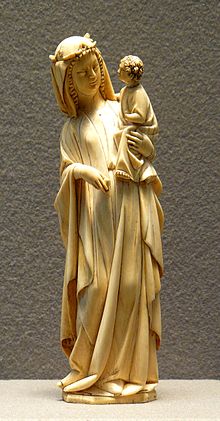
法国象牙圣母和圣婴,13 世纪末,高 25 厘米,曲线与象牙的形状相吻合。
The Gothic period is essentially defined by Gothic architecture, and does not entirely fit with the development of style in sculpture in either its start or finish. The facades of large churches, especially around doors, continued to have large tympanums, but also rows of sculpted figures spreading around them.
哥特式时期主要是由哥特式建筑定义的,与雕塑风格发展的起点和终点并不完全一致。大型教堂的外墙,尤其是门的周围,继续使用大型浮雕,但周围也有成排的雕像。
The statues on the Western (Royal) Portal at Chartres Cathedral (c. 1145) show an elegant but exaggerated columnar elongation, but those on the south transept portal, from 1215–20, show a more naturalistic style and increasing detachment from the wall behind, and some awareness of the classical tradition. These trends were continued in the west portal at Reims Cathedral of a few years later, where the figures are almost in the round, as became usual as Gothic spread across Europe.[15] Bamberg Cathedral has perhaps the largest assemblage of 13th century sculpture, culminating in 1240 with the Bamberg Rider, the first life-size equestrian statue in Western art since the 6th century.
沙特尔大教堂西门(皇家)上的雕像(约 1145 年)表现出一种优雅但夸张的柱式伸长,但 1215-20 年南门上的雕像则表现出一种更加自然的风格,与后面的墙壁越来越疏远,并在一定程度上体现了古典传统。这些趋势在几年后兰斯大教堂的西门上得到了延续,那里的人物几乎都是圆形的,这也是哥特式风格在欧洲蔓延时的惯用手法。班贝克(Bamberg)大教堂可能拥有最大规模的 13 世纪雕塑群,1240 年的 "班贝克骑士"(Bamberg Rider)达到了顶峰,这是自 6 世纪以来西方艺术中第一座真人大小的马术雕像。
"In Italy the Gospel of Gothic was preached from pulpits not from tympana, and the unit of the sculptor's thinking was an autonomous, self-consistent work of art" (John Pope-Hennessy).[16]
Nicola Pisano (1258–78) and his son Giovanni developed a style that is often called Proto-Renaissance, with unmistakable influence from Roman sarcophagi and sophisticated and crowded compositions, including a sympathetic handling of nudity, in relief panels on their pulpit of Siena Cathedral (1265–68), Pulpit in the Pisa Baptistery, the Fontana Maggiore in Perugia, and Giovanni's pulpit in Pistoia of 1301.[17]
"在意大利,哥特式的福音是在讲坛上而不是在大鼓上传播的,雕塑家的思想单位是一件独立、自成一体的艺术作品"(约翰-波普-亨内西)。尼古拉-皮萨诺(Nicola Pisano,1258-78 年)和他的儿子乔瓦尼(Giovanni)在锡耶纳大教堂布道坛(1265-68 年)、比萨洗礼堂布道坛、佩鲁贾的马焦雷方塔以及 1301 年乔瓦尼在皮斯托亚的布道坛的浮雕板上,明确无误地表现出罗马石棺的影响和复杂而拥挤的构图,包括对裸体的同情处理。 [17]
Another revival of classical style is seen in the International Gothic work of Claus Sluter and his followers in Burgundy and Flanders around 1400.[18] Late Gothic sculpture continued in the North, with a fashion for very large, wooden, sculpted altarpieces with increasingly virtuoso carving and large numbers agitated expressive figures; most surviving examples are in Germany, after much iconoclasm elsewhere. Tilman Riemenschneider, Veit Stoss and others continued the style well into the 16th century, gradually absorbing Italian Renaissance influences.[19]
另一种古典风格的复兴体现在 1400 年左右勃艮第和佛兰德斯的克劳斯-斯鲁特及其追随者的国际哥特式作品中。晚期哥特式雕塑在北方继续发展,以大型木雕祭坛作品为时尚,雕刻技艺日趋精湛,人物形象大量涌现,极富表现力。蒂尔曼-里门施耐德(Tilman Riemenschneider)、维特-斯托斯(Veit Stoss)等人将这一风格一直延续到 16 世纪,并逐渐吸收了意大利文艺复兴时期的影响。 [19]
Life-size tomb effigies in stone or alabaster became popular for the wealthy, and grand multi-level tombs evolved, with the Scaliger Tombs of Verona so large they had to be moved outside the church. By the 15th century there was an industry exporting Nottingham alabaster altar reliefs in groups of panels over much of Europe for economical parishes who could not afford stone retables.[20]
石头或雪花石膏制作的真人大小的坟墓雕像开始受到富人的青睐,宏伟的多层坟墓也逐渐发展起来,维罗纳的斯卡利格(Scaliger)坟墓非常大,不得不移到教堂外面。到 15 世纪,出口诺丁汉雪花石膏祭坛浮雕的行业已经遍布欧洲大部分地区,为那些买不起石制祭坛的经济型教区提供服务。 [20]
-
Nicola Pisano, Nativity and Adoration of the Magi from the pulpit in the Pisa Baptistery, 1260.
尼古拉-皮萨诺(Nicola Pisano),1260 年在比萨洗礼堂讲坛上创作的《耶稣降生和玛吉崇拜》。 -
Base of the Holy Thorn Reliquary, French (Paris), 1390s, a Resurrection of the Dead in gold, enamel and gems.
圣荆棘灵位底座,法国(巴黎),1390 年代,用黄金、珐琅和宝石制作的亡者复活图。 -
Man of Sorrows on the main portal of Ulm Münster by Hans Multscher, 1429.
1429 年汉斯-穆特舍尔(Hans Multscher)创作的乌尔姆明斯特(Ulm Münster)正门上的 "悲哀之人"。 -
Panelled altarpiece section with Resurrection of Christ, English Nottingham alabaster, 1450–90, with remains of colour.
基督复活的镶板祭坛壁画部分,英国诺丁汉青灰石膏,1450-90 年,有颜色残留。 -
Later Gothic depiction of the Adoration of the Magi from Strasbourg Cathedral.
出自斯特拉斯堡大教堂的后期哥特式描绘的《玛吉的崇拜》。 -
Detail of the Last Supper from Tilman Riemenschneider's Altar of the Holy Blood, 1501–05, carved limewood, Rothenburg ob der Tauber, Bavaria.
蒂尔曼-里门施耐德(Tilman Riemenschneider)1501-05 年作品《圣血祭坛》中《最后的晚餐》的细节,椴木雕刻,巴伐利亚罗滕堡陶伯河畔。
Portable sculpture 便携式雕塑[edit]

华特士棺的棺盖,左侧为《爱情城堡之围》,右侧为比武。巴黎,1330-1350 年。
Small carvings, for a mainly lay and often female market, became a considerable industry in Paris and some other centres. Types of ivories included small, devotional polyptychs, single figures, especially of the Virgin, mirror-cases, combs, and elaborate caskets with scenes from Romances, used as engagement presents.[21] The very wealthy collected extravagantly elaborate, jewelled and enamelled metalwork, both secular and religious, like the Duc de Berry's Holy Thorn Reliquary, until they ran short of money, when they were melted down again for cash.[22]
在巴黎和其他一些中心,主要面向非宗教人士(通常是女性)市场的小型雕刻品已成为一项相当可观的产业。象牙的种类包括小型虔诚多联画、单人雕像(尤其是圣母像)、镜盒、梳子和精致的匣子,匣子上雕刻着用作订婚礼物的罗曼史中的场景。0#非常富有的人收集奢华精致、镶有珠宝和珐琅的金属制品,既有世俗的,也有宗教的,比如贝里公爵的圣荆棘圣物,直到他们缺钱的时候,这些金属制品就会被再次熔化以换取现金。 [22]

象牙双联画,部分彩色颜料残留。玛吉的崇拜和耶稣受难。法国默兹河谷,约 1350 年。
Gothic sculptures independent of architectural ornament were primarily created as devotional objects for the home or intended as donations for local churches,[23] although small reliefs in ivory, bone and wood cover both religious and secular subjects, and were for church and domestic use. These sculptures were created by urban artisans, and the most common theme for three-dimensional small statues is the Virgin Mary alone or with a child.[24] Paris was the main centre of ivory workshops, and exported to most of northern Europe, though Italy also had a considerable production. An exemplar of these independent sculptures is among the collections of the Abbey Church of St Denis; the silver-gilt Virgin and Child dates to 1339 and features Mary enveloped in a flowing cloak holding an infantile Christ figure.[24] Both the simplicity of the cloak and the youth of the child presage other sculptures found in northern Europe dating to the 14th century and early 15th century.[24] Such sculpture shows an evolution from an earlier stiff and elongated style, still partly Romanesque, into a spatial and naturalistic feel in the late 12th and early 13th century.[24] Other French Gothic sculptural subjects included figures and scenes from popular literature of the time.[24] Imagery from the poetry of the troubadours was particularly popular among artisans of mirror-cases and small boxes presumably for use by women.[24] The Casket with Scenes of Romances (Walters 71264) of 1330–50 is an unusually large example with space for a number of scenes from different literary sources.
独立于建筑装饰之外的哥特式雕塑主要是作为家庭虔诚用品或当地教堂的捐赠品而创作的, [23] 尽管象牙、骨和木质的小型浮雕涵盖了宗教和世俗主题,并供教堂和家庭使用。这些雕塑是由城市工匠创作的,立体小雕像最常见的主题是圣母玛利亚独自一人或与一个孩子在一起。 [24] 巴黎是象牙作坊的主要中心,出口到北欧的大部分地区,但意大利也有相当大的产量。圣德尼修道院教堂收藏了这些独立雕塑中的一个典范;镀银的圣母子雕像可追溯到 1339 年,雕像中的圣母披着飘逸的斗篷,怀抱着襁褓中的基督。 [24] 斗篷的简洁和圣婴的年轻都预示了 14 世纪和 15 世纪早期在北欧发现的其他雕塑。 [24] 这些雕塑表明,在 12 世纪末和 13 世纪初,早期僵硬和拉长的风格(仍有部分罗马式风格)逐渐演变为空间感和自然主义风格。 [24] 其他法国哥特式雕塑题材还包括当时流行文学中的人物和场景。5# 行吟诗人诗歌中的意象尤其受到镜盒和小盒子(可能是供妇女使用的)工匠的青睐。 [24] 1330-50 年的 "带浪漫主义场景的匣子"(沃尔特斯 71264 号作品)是一个不同寻常的大型作品,其空间可容纳来自不同文学来源的多个场景。
Souvenirs of pilgrimages to shrines, such as clay or lead badges, medals and ampullae stamped with images were also popular and cheap. Their secular equivalent, the livery badge, showed signs of feudal and political loyalty or alliance that came to be regarded as a social menace in England under bastard feudalism. The cheaper forms were sometimes given away free, as with the 13,000 badges ordered in 1483 by King Richard III of England in fustian cloth with his emblem of a white boar for the investiture of his son Edward as Prince of Wales,[25] a huge number given the population at the time. The Dunstable Swan Jewel, modelled fully in the round in enamelled gold, is a far more exclusive version, that would have been given to someone very close or important to the donor.
朝拜圣地的纪念品,如泥制或铅制徽章、奖章和印有图像的安瓿瓶也很受欢迎,而且价格低廉。它们的世俗等同物--徽章,显示了封建和政治上的忠诚或联盟,在私生子封建制下的英国,这种徽章被视为一种社会威胁。廉价的徽章有时会免费赠送,例如 1483 年英国国王理查德三世为他的儿子爱德华举行威尔士亲王就职仪式时订购了 13000 枚徽章,这些徽章用福斯坦布制成,上面印有他的白野猪徽章。邓斯泰布尔天鹅珠宝是用珐琅彩金制作的圆形珠宝,是一个更为独特的版本,应该是赠送给捐赠者非常亲近或重要的人的。
See also 另请参见[edit]
维基共享资源中有与哥特式艺术相关的媒体。
维基共享资源中有与哥特式画家相关的媒体。
- Blackletter (also known as Gothic script)
黑体字 - Church frescos in Denmark
丹麦的教堂壁画 - Church frescos in Sweden
瑞典的教堂壁画 - Danse Macabre 恐怖之舞
- Gothic cathedrals and churches
哥特式大教堂和教堂 - History of painting 绘画史
- List of Gothic artists
哥特式艺术家名单 - Pleurants 画家
- Renaissance of the 12th century
12 世纪的文艺复兴 - The Ten Virgins 十圣母
- Timeline of Italian artists to 1800
1800 年之前的意大利艺术家年表 - Western painting 西方绘画
Notes 注释[edit]
- ^ Stokstad (2005), 516. 斯托克斯塔德(2005 年),第 516 页。
- ^ Stokstad (2005), 544. 斯托克斯塔德(2005 年),第 544 页。
- ^ Émile Mâle, The Gothic Image, Religious Art in France of the Thirteenth Century, pp. 165–8, English trans of 3rd edn, 1913, Collins, London (and many other editions) is a classic work on French Gothic church art
- ^ "Gothic art". Encyclopedia Britannica. Retrieved 22 June 2017.
- ^ Jump up to: a b c d History of Architecture Super Review. Research & Education Assoc. ISBN 978-0-7386-6996-0.
- ^ E. S. de Beer, Gothic: Origin and Diffusion of the Term; The Idea of Style in Architecture in Journal of the Warburg and Courtauld Institutes, Vol.11, 1948, pp. 143–62
- ^ Vasari, Giorgio (1 January 1960). Vasari on Technique. Being the Introduction to the Three Arts of Design, Architecture, Sculpture and Painting, Prefixed to the Lives of the Most Excellent Painters, Sculptors and Architects. Dover Publications. ISBN 978-0-486-20717-9.
- ^ The art of the sublime: principles of Christian art and architecture by Roger Homan p. 70 [1]
- ^ Kirsten Trampedach: Introduction to Danish Wall Paintings – Conservation Ethics and Methods of Treatment. National Museum of Denmark Archived 24 November 2009 at the Wayback Machine. Retrieved 6 September 2009.
- ^ Coe, 8–11 Coe, 8-11
- ^ Stokstad (2005), 540. 斯托克斯塔德(2005 年),540 页。
- ^ Jump up to: a b c d Stokstad (2005), 541.
- ^ Stokstad (2005), 542.
- ^ Lane, Barbara G,The Altar and the Altarpiece, Sacramental Themes in Early Netherlandish Painting, Harper & Row, 1984, ISBN 0-06-430133-8 analyses all these works in detail. See also the references in the articles on the works.
- ^ Honour and Fleming, 297–300; Henderson, 55, 82–84
- ^ Pope-Hennessy, 11
- ^ Olson, 11–24; Honour and Fleming, 304; Henderson, 41
- ^ Snyder, 65–69
- ^ Snyder, 305–311
- ^ [2]V&A Museum feature on the Nottingham alabaster Swansea Altarpiece
- ^ Calkins, 193–198
- ^ Cherry, 25–48; Henderson, 134–141
- ^ Stokstad (2005), 537.
- ^ Jump up to: a b c d e f Stokstad (2005), 539.
- ^ Cherry (2003), 204
References[edit]
- Calkins, Robert G.; Monuments of Medieval Art, Dutton, 1979, ISBN 0525475613
- Cherry, John. The Holy Thorn Reliquary, 2010, British Museum Press (British Museum objects in focus), ISBN 0-7141-2820-1
- Cherry, John, in Marks, Richard and Williamson, Paul, eds. Gothic: Art for England 1400–1547, 2003, V&A Publications, London, ISBN 1-85177-401-7
- Focillon, Henri (1980). The Art of the West in the Middle Ages: Vol. 2 - Gothic. Ithaca, NY: Cornell University Press. ISBN 978-0801491924.
- Henderson, George. Gothic, 1967, Penguin, ISBN 0-14-020806-2
- Hugh Honour and John Fleming, A World History of Art, 1st edn. 1982 (many later editions), Macmillan, London, page refs to 1984 Macmillan 1st edn. paperback. ISBN 0333371852
- Olson, Roberta J.M., Italian Renaissance Sculpture, 1992, Thames & Hudson (World of Art), ISBN 978-0-500-20253-1
- Pope-Hennessy, John, Introduction to Italian Sculpture, Volume 1, Italian Gothic Sculpture, 1955, Fourth Edition 1996, Phaidon Press, ISBN 0-7148-3014-3
- Robinson, James, Masterpieces of Medieval Art, 2008, British Museum Press, ISBN 978-0-7141-2815-3
- Rudolph, Conrad, ed., A Companion to Medieval Art: Romanesque and Gothic in Northern Europe, 2006, ISBN 978-1405198783
- Rudolph, Conrad, "Inventing the Gothic Portal: Suger, Hugh of Saint Victor, and the Construction of a New Public Art at Saint-Denis," Art History 33 (2010) 568–595
- Rudolph, Conrad, "Inventing the Exegetical Stained-Glass Window: Suger, Hugh, and a New Elite Art," Art Bulletin 93 (2011) 399–422
- Snyder, James. Northern Renaissance Art, 1985, Harry N. Abrams, ISBN 0136235964
External links[edit]
- Gothic art, from ArtCyclopedia.com
- Gothic art, from Encyclopædia Britannica Online.
- Gothic art (Archived 2009-10-31), from Microsoft Encarta.
- Gothic art Archived 5 March 2005 at the Wayback Machine, from The Columbia Encyclopedia, Sixth Edition. 2001.
- Gothic art, Museumsportal Schleswig-Holstein
- Gothic art, from "A World History of Art" and [3].
- "Gothic: Art for England 1400–1547". Victoria and Albert Museum. Retrieved 8 June 2007.
- The Pietà in French late Gothic sculpture: regional variations, a book from The Metropolitan Museum of Art Libraries (fully available online as PDF), which contains material on Gothic art


